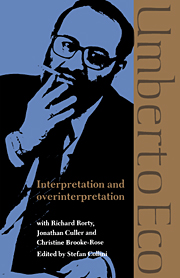1 - Interpretation and history
Published online by Cambridge University Press: 03 February 2010
Summary
In 1957 J.M. Castillet wrote a book entitled La hora del lector(‘The hour of the reader’). He was indeed a prophet. In 1962 I wrote my Opera aperta. In that book I advocated the active role of the interpreter in the reading of texts endowed with aesthetic value. When those pages were written, my readers mainly focussed on the open side of the whole business, underestimating the fact that the open-ended reading I was supporting was an activity elicited by (and aiming at interpreting) a work. In other words, I was studying the dialectics between the rights of texts and the rights of their interpreters. I have the impression that, in the course of the last decades, the rights of the interpreters have been overstressed.
In my more recent writings (A Theory of Semiotics, The Role of the Reader, and Semiotics and the Philosophy of Language) I elaborated on the Peircean idea of unlimited semiosis. In my presentation at the Peirce International Congress at Harvard University (September 1989) I tried to show that the notion of unlimited semiosis does not lead to the conclusion that interpretation has no criteria. To say that interpretation (as the basic feature of semiosis) is potentially unlimited does not mean that interpretation has no object and that it ‘riverruns’ merely for its own sake. To say that a text has potentially no end does not mean that every act of interpretation can have a happy end.
- Type
- Chapter
- Information
- Interpretation and Overinterpretation , pp. 23 - 44Publisher: Cambridge University PressPrint publication year: 1992
- 15
- Cited by



